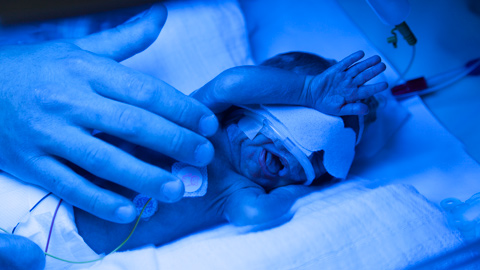Involving Parents in the Care Speeds up the Development of Preterm Infants
Joel is four days old. He weighs slightly over 1200 grams. He has sensors on his chest and a tube going in his nostrils. His father and mother are standing by him. Neonatologist Liisa Lehtonen knows that the participation of the parents in the care helps the little baby gain strength.

Blue light spreads over Joel. Professor of Paediatrics Liisa Lehtonen tells the new parents Iina and Niko Paukkunen that light turns the skin-yellowing bilirubin into a water-soluble form. Then it exits the body with urine, just as it does with full term infants.
The moment reveals what the Close Collaboration with Parents operating model of the University of Turku and Turku University Hospital is all about – the parents are immediately involved in the care of the baby.
– Together with the parents we learn to see when the baby is feeling good, what his or her stress signs are and how he or she interacts. In the case of a preterm infant, the ways of communication are also immature and difficult to observe. We must learn to see them, says Lehtonen.
The Parent's Hands Relieve Pain
The Close Collaboration with Parents operating model is based on research. Raija Latva demonstrated in her dissertation that if the mother gets to hold the baby even for a while after the birth and before the baby is taken to neonatal intensive care, it consolidates the maternal bond and the child has less behavioural and emotional problems later in life. The dissertation of Riikka Korja demonstrated that the more the mother carried the preterm infant of five months in her arms, the stronger the interaction between mother and child was at the age of 6–12 months. In addition, Anna Axelin demonstrated the significance of parents in pain relief in her dissertation.
– When the parent supported the preterm baby in fetal position with warm hands, while the baby underwent care procedures such as blood sampling from the heel or respiratory tract suction, the pain relief was as efficient as it would have been with painkillers, says Lehtonen.
The dissertation of Sami Raiskila in the Close Collaboration with Parents project demonstrated that when the breastfeeding of the babies was increased and began earlier, the weight of the babies was increased by 150 per cent.
– We do not know yet how big a part of the change is due to nutrition and how big a part is due to the fact that the child’s stress is reduced when the parent is nearby. Stress causes a high level of cortisol, which slows down growth. This is how soft culture turns into a measurable fact. The growth of a child’s brain correlates directly to the prognosis of development. Our biggest challenge is to make the preterm baby grow as if he or she would in the womb, says Lehtonen.
The latest research project is SCENE – Separation and Closeness Experience in Neonatal Environment. The first phase of the study entailed finding out the starting point of 13 hospitals situated in six different countries of Europe in involving the parents in the care. The research made use of a diary filled out by parents regarding the time spent in hospital and both the mother and the father were sent a text message every night with questions about the support they had been given and the opportunities to be involved in the hospital care of their baby.
The data is currently under examination, and the results will be published in the spring.
Text: Erja Hyytiäinen
Photos: Antti Tarponen
Translation: Aino Koivisto